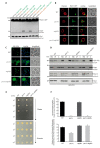The Peroxisomal PTS1-Import Defect of PEX1- Deficient Cells Is Independent of Pexophagy in Saccharomyces cerevisiae
- PMID: 32013259
- PMCID: PMC7037794
- DOI: 10.3390/ijms21030867
The Peroxisomal PTS1-Import Defect of PEX1- Deficient Cells Is Independent of Pexophagy in Saccharomyces cerevisiae
Abstract
The important physiologic role of peroxisomes is shown by the occurrence of peroxisomal biogenesis disorders (PBDs) in humans. This spectrum of autosomal recessive metabolic disorders is characterized by defective peroxisome assembly and impaired peroxisomal functions. PBDs are caused by mutations in the peroxisomal biogenesis factors, which are required for the correct compartmentalization of peroxisomal matrix enzymes. Recent work from patient cells that contain the Pex1(G843D) point mutant suggested that the inhibition of the lysosome, and therefore the block of pexophagy, was beneficial for peroxisomal function. The resulting working model proposed that Pex1 may not be essential for matrix protein import at all, but rather for the prevention of pexophagy. Thus, the observed matrix protein import defect would not be caused by a lack of Pex1 activity, but rather by enhanced removal of peroxisomal membranes via pexophagy. In the present study, we can show that the specific block of PEX1 deletion-induced pexophagy does not restore peroxisomal matrix protein import or the peroxisomal function in beta-oxidation in yeast. Therefore, we conclude that Pex1 is directly and essentially involved in peroxisomal matrix protein import, and that the PEX1 deletion-induced pexophagy is not responsible for the defect in peroxisomal function. In order to point out the conserved mechanism, we discuss our findings in the context of the working models of peroxisomal biogenesis and pexophagy in yeasts and mammals.
Keywords: Atg36; Pex1; peroxisomal protein import; pexophagy.
Conflict of interest statement
The authors declare no conflict of interest.
Figures

Similar articles
-
PEX1G843D remains functional in peroxisome biogenesis but is rapidly degraded by the proteasome.J Biol Chem. 2025 May;301(5):108467. doi: 10.1016/j.jbc.2025.108467. Epub 2025 Mar 28. J Biol Chem. 2025. PMID: 40158855 Free PMC article.
-
The peroxisomal exportomer directly inhibits phosphoactivation of the pexophagy receptor Atg36 to suppress pexophagy in yeast.Elife. 2022 Apr 11;11:e74531. doi: 10.7554/eLife.74531. Elife. 2022. PMID: 35404228 Free PMC article.
-
The peroxisomal AAA ATPase complex prevents pexophagy and development of peroxisome biogenesis disorders.Autophagy. 2017 May 4;13(5):868-884. doi: 10.1080/15548627.2017.1291470. Autophagy. 2017. PMID: 28521612 Free PMC article.
-
Pexophagy is responsible for 65% of cases of peroxisome biogenesis disorders.Autophagy. 2017 May 4;13(5):991-994. doi: 10.1080/15548627.2017.1291480. Epub 2017 Feb 28. Autophagy. 2017. PMID: 28318378 Free PMC article. Review.
-
Yeast peroxisomes: How are they formed and how do they grow?Int J Biochem Cell Biol. 2018 Dec;105:24-34. doi: 10.1016/j.biocel.2018.09.019. Epub 2018 Sep 27. Int J Biochem Cell Biol. 2018. PMID: 30268746 Review.
Cited by
-
PEX1 is essential for glycosome biogenesis and trypanosomatid parasite survival.Front Cell Infect Microbiol. 2024 Mar 6;14:1274506. doi: 10.3389/fcimb.2024.1274506. eCollection 2024. Front Cell Infect Microbiol. 2024. PMID: 38510966 Free PMC article.
-
Potential biomarkers in hypoglycemic brain injury.Forensic Sci Med Pathol. 2024 Sep;20(3):810-822. doi: 10.1007/s12024-023-00681-8. Epub 2023 Jul 19. Forensic Sci Med Pathol. 2024. PMID: 37466819
-
Mechanisms and Functions of Pexophagy in Mammalian Cells.Cells. 2021 May 3;10(5):1094. doi: 10.3390/cells10051094. Cells. 2021. PMID: 34063724 Free PMC article. Review.
-
Autophagy Stimulus-Dependent Role of the Small GTPase Ras2 in Peroxisome Degradation.Biomolecules. 2020 Nov 14;10(11):1553. doi: 10.3390/biom10111553. Biomolecules. 2020. PMID: 33202661 Free PMC article.
References
MeSH terms
Substances
Grants and funding
LinkOut - more resources
Full Text Sources
Molecular Biology Databases

